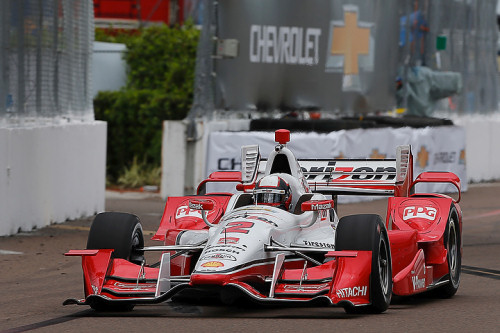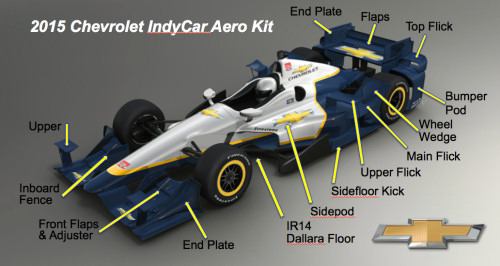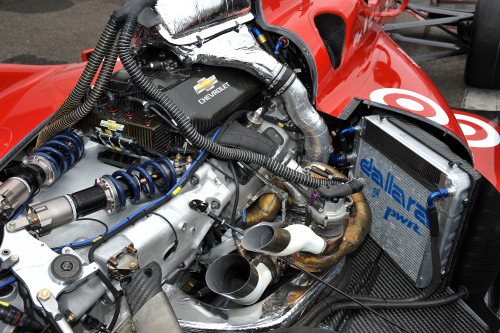The Way It Is/ Chevrolet's IndyCar aero kit programby Gordon Kirby |
 Last week I discussed IndyCar's aero kit program with Derrick Walker and Honda's Steve Eriksen. This week the discussion continues with Chris Berube, Chevrolet Racing's IndyCar program manager.
Last week I discussed IndyCar's aero kit program with Derrick Walker and Honda's Steve Eriksen. This week the discussion continues with Chris Berube, Chevrolet Racing's IndyCar program manager.
Chevrolet's re-entry into Indy car racing three years ago as a much-needed competitor to Honda was essential to IndyCar's hopes for rejuvenation and thus far Chevrolet's engine program has performed well. Working in company with longtime partner Ilmor Engineering in the UK and America, Chevrolet's engineers have produced a successful 2.2 liter turbo V6 engine, winning IndyCar's manufacturers championship in 2012, '13 and '14 and the Indy 500 in 2013. Berube says IndyCar's promise of this year's aero kit program was an important element in convincing his bosses in Detroit to re-enter Indy car racing. "The opportunity to do our own aero kit was one of the key reasons Chevrolet returned to Indy car racing," Berube said. "We started down this road three years ago once we had reasonable confidence that the aero kits were going to happen. There were some starts and stops along the way [with IndyCar] that we were part of and privy to and had to react to. "The whole process started with understanding the baseline which was the DW12 car and setting some goals and targets of what we wanted to do better. We wanted to provide our teams with a fully mapped car that worked that didn't require hours and ours of work to figure out. And that's what we've done. We've given them a well-written handbook on how it works and how it's validated. We accomplished that goal."  © Chevrolet Racing "We're very pleased with the way we've started the season," Berube said. "The performance we're seeing in the cars is what we predicted and we're happy with the results so far." Berube said the lessons learned about strengthening the aero kit from the St. Petersburg season-opener were quickly applied. "It was limited to just one part of the car, the upper part of the front wing assembly," he said. "The requirements they were designed to did not count on getting hit by other cars. They were certainly in a vulnerable position on the car and we recognized that. "They were there to produce downforce and it became obvious that there was going to be a learning curve for the drivers to wean themselves off running into each other, which could be expected given that the aero kit of previous years was of a different design that tolerated that. "The first step was to try and reinforce the base of that piece, which we did for the race at NOLA. It worked in some regards but you still have a 1,600 pound car hitting a one pound part which is not a favorable situation. In addition, it caused damage to some other parts. "When we got to Long Beach a choice was given to us to either not run with it or do something else, and we chose to remove it, at a deficit of course, to the performance of the car. But we have some bandwidth in the car and the guys quickly came up with some countermeasures and I think the results from Long Beach speak for themselves. It was obviously a countermeasure that worked." Berube acknowledges that this year's performance improvements come from both engine development and aero kits. "We developed the engine and aero kit together," he remarked. "We never ran one without the other so I can't give you an accurate number or percentage of improvement in performance from the engine or aero kit.  © Chevrolet Racing Berube says a special effort went into making Chevrolet's engines more responsive this year under hard acceleration off Long Beach's hairpin. "At Long Beach we had struggled with getting the power down coming out of the hairpin which sets up the long front straight so it's pretty critical to the lap time," he commented. "We worked on that separately on the engine side and we definitely had a much better result with that part of the track this year." Chevy and Honda's speedway kits will be unveiled next week and Berube is confident that Chevrolet's speedway aero package will be as good, maybe better, than its road course kit. "We're really excited to reveal our kit," he grins. "You will definitely see some differences in our car. Obviously the Speedway is a drag focused facet of the IndyCar competition so you certainly won't see as many elements as there are on the road course configuration. But we've got some unique elements that we're anxious to show the world and show the performance they will hopefully generate. "One of the unique things about IndyCar is that we compete at such a variety of venues and types of tracks that you can almost say it's a different car for the speedway versus our road course and short oval setup. The aero kit regulations presented some challenges that we had to make some decisions about upfront specifically relating to things that couldn't be different between the speedways and road courses. "So side pods and engine covers were major elements that have a role to play. Drag versus downforce had to be chosen with whatever the priority was so it will be interesting to see how the results of those choices play out when we get to the 500." Berube tips his hat to Arron Melvin, Chevrolet's chief aerodynamicist on the IndyCar program. "We have various technical partners working on the car," Berube said. "From the aero side we formed a team that had the skills to execute the program. Arron Melvin is our chief aerodynamicist. He spearheaded our aero kit development. "Arron has done an awesome job and the team he assembled and led under Chevrolet's guidance has been very productive. It's been amazing what they've been able to accomplish. Some of it was evident in the first couple of races and when we get to the Speedway we will see the full breadth of the effort."  © Chevrolet Racing "Along the way in the whole development process there have been methods of testing some of the impacts of the race program for future street car programs," he remarked. "The effect of signing up to do the aero kit for IndyCar has been well received by the leadership at GM. They're excited about what we've come up and the results so far. "At this point there are no regrets. It's definitely been a long process, longer than originally thought because of some of the setbacks along the way. You continue developing and spending money during that time frame so it's been a somewhat expensive endeavor but again it's been a great learning process along the way and we've benefitted from that process." Berube says IndyCar has recovered from its early stumbles in developing the aero kit concept. He adds that Chevrolet is pleased with the leadership exhibited by Derrick Walker and happy with its dialogue with IndyCar regarding future rules and regulations. "We're having ongoing conversations with IndyCar about where we go next with the aero kits and the car itself," Berube said. "Nothing has been decided yet." Based on the year's opening races Chevrolet is going to be tough to beat this year. Penske and Ganassi's pair of blue ribbon teams lead Chevy's attack with an impressive phalanx of eight cars, but Honda is a very worthy competitor, never to be underestimated, as demonstrated at Indianapolis in 2012 and again last year. The rivalry between Chevrolet and Honda is without doubt IndyCar's most powerful driving force. From each manufacturer's perspective the aero kit program has been a useful and healthy boost. We hope it will evolve into a better future for all. |
|
Auto Racing ~ Gordon Kirby
Copyright ~ All Rights Reserved |
